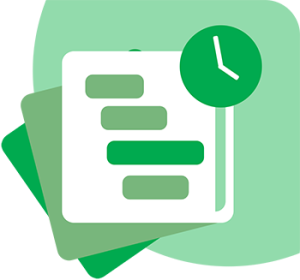The retirement terms you need to know!

Building a pension is important, you know that. But it sounds dull, complicated and like a subject you’d rather pass by. We get that! But trust us: taking matters into your own hands for a financially good old age is important and not nearly as complicated as it seems. In this article, we highlight the most important and used terms. Here we go, the retirement terms you need to know!
Psst: start building your own retirement? Then read this retirement step-by-step plan!
Pension pillars
Before we immerse you in all the need to know retirement terms, we’d like to explain that your pension accrual consists of 3 pillars:
- AOW: the social provision in the Netherlands. Everyone gets AOW.
- Collective: Old-age pension or employer pension.
- Annuity: Your own retirement pot, in an account at bank or investment institution.
Let’s start with an A!
The Anw is the abbreviation for the General Survivors Act. No nice subject, but should you die, the Anw entitles your partner to a survivor’s benefit if he or she is under 65. Partner means the person with whom you were married, had a registered partnership, or shared a common household. Eligibility for an Anw benefit (with the exception of orphan’s benefit) depends on the survivor’s age, family composition and degree of work (in)eligibility. Your own income, if any, also affects the amount of the Anw benefit. The
Social Insurance Bank (SVB)
pays this benefit.
Survivor and partner pension
The category of survivor includes the Survivor Pension. This is a collective term for widow’s, widower’s and partner’s pensions. This is pension paid to a widow, widower or unmarried partner of the deceased member of a pension plan.
You will also find in this category the partner’s pension. This is the pension that is paid to your partner when you die. Partner means the person with whom you were married or had a registered partnership (so put a ring on it 😉 ). Often, a partner is also defined as the person with whom the deceased insured person shared a common household.
AOW: general old age law
Then when you reach your state pension age you are entitled to AOW. This stands for General Old Age Security Act. This benefit is a basic pension and starts on the day you reach your state pension age. On the central government website is included a module to make the state pension age calculate. The AOW benefit lasts until the last day of the month in which you die. The amount of the AOW pension depends on your marital status and family situation. Again, the
Social Insurance Bank (SVB)
again this benefit.
Not to be confused with the AOW is the old-age pension or employer pension. This is a benefit the you get when you reach retirement age. This benefit is for life and is paid monthly.
VUT stands for early retirement. Early retirement allows you to retire earlier than age 67. As of Jan. 1, 2006, early retirement plans are no longer allowed for tax purposes, except for participants born before Jan. 1, 1950. We encounter this very little in 2023.
The B of investing.
You wouldn’t think it but to make sure your pension fund can meet all its commitments they will have to invest the pension contributions paid as carefully as possible. This is called a investment policy. A pension fund, on the one hand, tries to achieve as much return as possible and, on the other hand, to eliminate risks as much as possible. An important part of the investment policy is the allocation of assets among different investment categories, for example, in stocks and in bonds.
Collective pension plan
Sometimes there is a group pension plan. In this case, an employer has entered into a pension plan for all employees, or a specific group. Everyone participating in this scheme then has the same (type of) pension plan. What exactly does this mean? Every employer who is a member of a pension fund and has a plan for his/her employees makes monthly contributions, either themselves or together with their employees. The employer can do this entirely for you himself or in cooperation by contributing a percentage of your monthly income.
The group pension plan falls under pillar 2.
Factor A
A factor A (applicable only to pillar 2 pensions) is the factor that indicates what the pension accrual has been in a given year, that is, how much your employer (possibly along with you) has contributed to your pension. Your pension provider must provide you with an annual statement of factor A, as you need it to calculate your annual margin. We’ll come back to that later in the piece.
Final salary plan
A pension plan in which the amount of your pension is derived from the salary you earned immediately prior to the retirement date is called a final salary scheme With each salary increase, the pension you have already accrued is adjusted to the new salary level.
Pension investing interesting?
Fiscal benefit. Will we, of course. How so?
Suppose you earn €36,000 gross per year. Then you pay 36.93% tax on your income. Your employer helps you build your pension, and together you contribute €200 a month.
However, your annual margin shows that you may add another €1850 to your pension pot this year. And because the IRS wants to reward you, you get tax back on that €1850.
How much? That 36.93%! That means you deposit €1850 in your retirement account now for later, and get €683 back for it on the upcoming income tax return round. You may offset that during your income tax return.
Please note that this example is illustrative. What your tax return looks like has to do with more aspects than just your pillar 3 pension contributions.
FOR: fiscal retirement reserve
FOR (tax-deferred retirement reserve). If you are an entrepreneur now, you still have a tax advantage until December 31, 2022, because you can set aside a portion of your earnings tax-free for retirement. The portion of your earnings that you set aside is called the “addition or tax-deferred retirement reserve. At your retirement age, you can use the amount Have it paid out at a lower state pension tax rate. The retirement reserve addition is an accounting reserve. That is, you are not actually required to set the money aside in a designated account. So you decide entirely what to do with the retirement reserve, but one thing is certain: you always pay less tax on it than you do now.
Unfortunately this scheme expires in 2023
. Fortunately, a very good solution to this is to build up a pension in pillar 3.
Also in the tax category is the reversal rule. Normally everything you get from your employment (wages, etc.) is taxed. In retirement, it is different. Pension contributions are not part of taxable wages, but pension benefits.
Annual space
Annual space is based on your income and the pension you accrue through your employer. If you have annual allowance, you can deposit this amount in an escrow retirement account. Part of the deposit you then get back through your income tax return. Have you accrued less pension in recent years than you should be allowed to accrue by the Internal Revenue Service? Then you probably have unused annual space. You are allowed by the IRS to make additional use of your unused annual margin up to 7 years back. This is called the reserve room. The reserve allowance, like the annual allowance, is tax deductible. Rules do apply to the use of the reserve space, especially with regard to the maximum amount you may deposit. Brand New Day has a handy tool for the calculating your annual margin.
Reservation space
Speaking of reserve space, this is the sum of the annual spaces you haven’t used in the past 10 years. Say your annual space was €1,000 every year for the past 10 years, but you didn’t use it, then your reserve space is €10,000. You would then be allowed to deposit this into a special retirement account, and you would receive tax benefits on it. Exactly how much you are allowed to start and how much you get back all depends on your personal situation and the rules of our friends at the IRS.
Annuity payment
Annuity payment, here you must have heard of. Annuity payment is nothing more or less than An amount paid monthly, quarterly or annually for a definite or indefinite period. Usually intended as a full pension or to supplement a small pension.
When your pension is based on the average salary earned, we refer to it as an average pay plan. Each year you accrue pension on the then current salary. The percentage of pensionable earnings by which the annual pension to be accrued is calculated is called the accrual rate.
What to do when job hopping?
There may be a pension disadvantage if you change jobs and therefore pension plans. The pension already accrued with your old employer is then sometimes not fully adjusted to price or wage trends. That means loss of purchasing power and that’s called pension breach
The new pension law “Future Pension Act” means that things may change in this area (and many pension areas). Read an update here.
Pension Fund
A pension fund administers the employer’s pension plan. Pension funds are supervised by the Dutch Central Bank (DNB) and the Financial Markets Authority (AFM). Money is raised in this fund for the purpose of securing the employer’s pension commitment. In short, that you if you have the retirement age (targeted at 67 since Jan. 1, 2014) is reached, you get just the pennies you were promised. At a pension fund you pay yes; pension contribution. Premium you pay to fund the pension plan. Usually you and your employer pay part of the premium.
But what to do when there is a pension gap? Already doesn’t sound very positive, does it? You don’t expect it, but a pension gap exists in almost every employee. In fact, you have a sufficient pension at about 70 percent of your income, but if you save for retirement through your employer, you often end up with less than 40 percent (!). Some employers leave no annual allowance unused and build up well for you; however, these are few and far between. You then, indeed, face a pension gap.
To determine whether a pension gap exists, you need to have an overview of your financial situation. A UPO or Uniform Pension Statement can be useful. Also read this article where we explain what you can do yourself to fill your pension gap.
The pension system
In the Netherlands, there are three ways to build up a pension. First of all, every Dutch citizen is entitled to AOW, a pension provided by the government. We’ve talked about this before. In addition, a large proportion of the Dutch build up a pension through a pension plan (pension fund) with the employer. The third way is a voluntary, individual retirement plan. This allows employees without an (adequate) pension plan or self-employed workers to build up (additional) pensions themselves. The latter, building your own pension in pillar 3, you can do by saving for retirement or – investing in a personal account.
In the Netherlands, there is also a pay-as-you-go system. This is a form of financing in which working people pay contributions, which at the same time pay benefits to pensioners. In the Netherlands, the pay-as-you-go system is used, among other things, to finance the AOW and the VUT-regulation. The Pension Act (The body of applicable legal regulations on pension) Does not allow the pay-as-you-go system for pension entitlements.
And if you no longer want to play along?
If you stop participating in the pension plan, you retain the right to the pension you have already accrued. You no longer have to pay a premium for that. Hence the term non-contributory entitlement.
Pillar 3, annuities
We have focused a lot in this piece on pillar 1 and 2. Two pillars where you actually have pretty little control yourself in terms of pension accrual. Where you do have influence and a lot of freedom is pillar 3, annuities, or retirement investing. Read all about retirement investing here.




